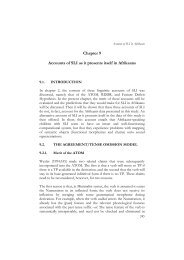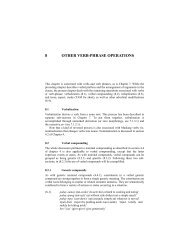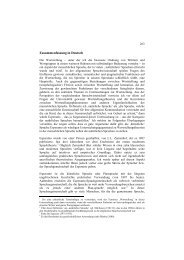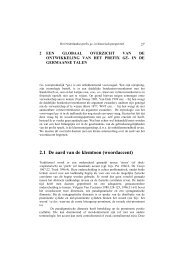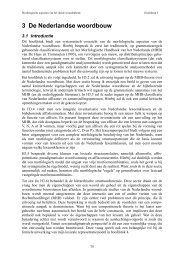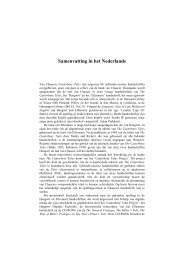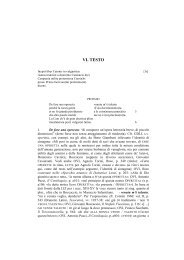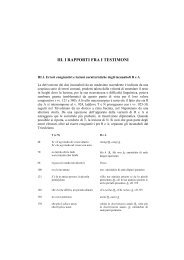chapter 2 stance adverbs qualifying a standpoint - LOT publications
chapter 2 stance adverbs qualifying a standpoint - LOT publications
chapter 2 stance adverbs qualifying a standpoint - LOT publications
You also want an ePaper? Increase the reach of your titles
YUMPU automatically turns print PDFs into web optimized ePapers that Google loves.
68<br />
CHAPTER 2<br />
suggests that the <strong>standpoint</strong> he is advancing is in line with the antagonist‟s<br />
expectations and signals that he shares this evaluation with him.<br />
2.3.3 Stance <strong>adverbs</strong> commenting on the performance of the<br />
act<br />
The <strong>adverbs</strong> that can be used as the linguistic realisation of the ‘illocutionary’ way<br />
of <strong>qualifying</strong> <strong>standpoint</strong>s 48 add a comment that concerns the act that is being<br />
performed, not the content of the act. Such a comment indicates the language<br />
user‟s awareness of the conditions that pertain to the performance of an<br />
assertive speech act. As a result, the protagonist who uses this way of <strong>qualifying</strong><br />
comments on his sincerity and cooperativeness when performing a particular<br />
act or on the expectations that his interlocutor has about the performance of<br />
that act. In section 2.3.3.1, I argue that the <strong>adverbs</strong> that constitute the linguistic<br />
realisation of this way of <strong>qualifying</strong> come both from the group of the so-called<br />
„illocutionary <strong>adverbs</strong>‟ (frankly, honestly, seriously), and from a group of <strong>adverbs</strong><br />
that are usually included among the epistemic <strong>adverbs</strong> or treated in the<br />
literature under the label of „expectation markers‟ (actually, admittedly, in fact, of<br />
course). 49 In section 2.3.3.2, I argue that the discourse effect of this way of<br />
<strong>qualifying</strong> the <strong>standpoint</strong> is to emphasise the protagonist‟s cooperativeness.<br />
2.3.3.1 Illocutionary <strong>adverbs</strong> and expectation markers<br />
The <strong>adverbs</strong> that can be used to qualify a <strong>standpoint</strong> in the „illocutionary‟ way<br />
belong to the group of <strong>adverbs</strong> that are known in the literature as „illocutionary<br />
<strong>adverbs</strong>‟ (Bach & Harnish, 1979), „pragmatic <strong>adverbs</strong>‟ (Bellert, 1977) or „speechact<br />
related adverbials‟ (Huddleston & Pullum, 2002). In this section, besides<br />
presenting these <strong>adverbs</strong>, I argue that <strong>adverbs</strong> like actually, in fact, in reality, and of<br />
course, which tend to be grouped together with modal <strong>adverbs</strong> or which appear<br />
labelled as „expectation markers‟ (Aijmer & Simon-Vandenbergen, 2004;<br />
Simon-Vandenbergen & Aijmer, 2002), may also count as <strong>qualifying</strong> the<br />
<strong>standpoint</strong> by commenting on the act as a whole, rather than as commenting<br />
on the commitment to the proposition.<br />
Next to the groups of <strong>adverbs</strong> that Quirk et al. identify as „content<br />
disjuncts‟, under which the <strong>adverbs</strong> presented in the previous two subsections<br />
fall, the authors distinguish two more groups, under the label of „style<br />
disjuncts‟. The one group indicates „modality and manner‟ and includes <strong>adverbs</strong><br />
such as:<br />
48 I am aware of the confusion that the use of „illocutionary‟ as a label for this way of <strong>qualifying</strong><br />
<strong>standpoint</strong>s may cause, since all three ways of <strong>qualifying</strong> pertain to the illocutionary level at which<br />
<strong>standpoint</strong>s are analysed, as I have argued in 1.4. For lack of any other term, I have chosen to call<br />
this way after the most recurrent term with which the <strong>adverbs</strong> that constitute the linguistic<br />
realisation of it are labelled in the literature (see „illocutionary <strong>adverbs</strong>‟).<br />
49 For a detailed list, see the third column in Table 2.




